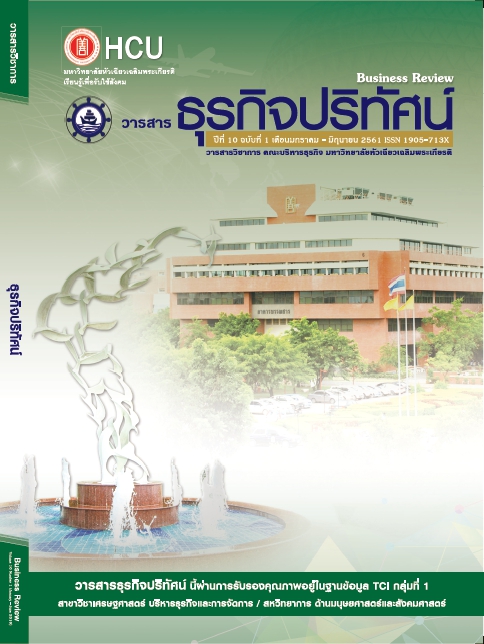A Development of Social Responsibility Indicator for Private Vocational Institutes of Business Administration
Keywords:
Social Responsibility, Private Vocational Institutes, Business AdministrationAbstract
The purposes of this research were: 1) to develop the social responsibility indicator
of the private vocational institute of business administration. 2) to confirmation component
of the social responsibility indicator 3) to study of the probability of using the indicator to
measure the social responsibility for Private Vocational Institute of Business Administration.
The data were collected from Private Vocational School of Business in year 2015, used in
this study of 660 by Multistage Random Sampling Statistical analysis methods used were
frequency, a confirmatory factor analysis, Construct reliability, Average variance extracted.
The results of the study that the social responsibility indicator of private vocational
institutes. 5 areas of business management are stakeholders. Environmental, economic,
social, cultural, and voluntary. Each side has an average level of significance. And there
was consistency between performance and expectation at statistically significant level .05.
The Results of Confirmative Elements of Social Responsibility Indicators of Private
Vocational Institutes Type of Business was consistent with empirical data. And the
feasibility study on the use of indicators to measure social responsibility of Private
Vocational Institute of Business Administration. It was found that the groups with high
mean. There was a high level of social responsibility in the top 5, with the view that
sustainable development should be promoted as a result of the country’s economic
foundation. And low average groups there was two main areas of social responsibility:
social, cultural and volunteer. They have the opinion that they could visualize the activities
that they did. And promote the image of private vocational institutes.
References
ในการแข่งขัน อย่างยั่งยืน. นนทบุรี: ธิงค์ บียอนด์ บุ๊กส.
ภาวิณีย์ มาตแม้น. (2557). ปัจจัยทางการตลาดเพื่อพัฒนาภาพลักษณ์วิทยาลัยอาชีวศึกษาเอกชน.
วารสารสุโขทัยธรรมาธิราช, 26(2), 94-105.
สมาคมสถาบันการศึกษาเอกชนแห่งประเทศไทย. (2558). สืบค้นเมื่อ วันที่ 3 ธันวาคม พ.ศ. 2558
http://www.apheit.org/
สำนักงานสถิติแห่งชาติ. (2557). การสำรวจความต้องการแรงงานและการขาดแคลนแรงงานของสถาน
ประกอบการ. กรุงเทพฯ: สำนักสถิติพยากรณ์.
สำนักงานเลขาธิการสภาการศึกษา. (2557). รายงานประจำปี 2557 สำนักงานเลขาธิการสภาการศึกษา
กับพันธกิจพัฒนาการศึกษาชาติ. กรุงเทพฯ: บริษัท 21 เซ็นจูรี่ จำกัด.
สำนักงานคณะกรรมการอาชีวศึกษา. (2557). ภารกิจและนโยบาย. สืบค้นเมื่อ 3 มกราคม พ.ศ. 2558,
เว็บไซต์ http://www.vec.go.th/Default.aspx?tabid=87
Hair, J. F., Black, W. C., Babin, B. J., & Anderson, R. E. (2010). Multivariate data analysis (7th
ed.). New Jersey: Prentice Hall, Upper Saddle River.
Kim, R. C., & O’Gorman, K. D. (2011). Corporate social responsibility as a dynamic internal
organizational process: A case study. Journal of Business Ethics, 101(1), 61-74.
Kotler, P., & Lee, N. (2551). Corporate social responsibility doing the most good for your
company and your cause (รมณียฉัตร แก้วกิริยา, แปล). กรุงเทพฯ: ยูนิเวอร์แซลพับลิชิ่ง.
Krejcie, R. V., & Morgan, D. W. (1970). Determining sample size for research activities.
Educational and Psychological Measurement, 30(3), 607-610.
Schreck, P. (2011). Review the business case for corporate social responsibility: New evidence and
analysis. Journal of International business Ethics, 10(1), 167-188.
Downloads
Published
How to Cite
Issue
Section
License
All articles published in the Business Administration and Management Journal Review are copyrighted by the journal.
The views and opinions expressed in each article are solely those of the individual authors and do not represent those of Huachiew Chalermprakiet University or any other faculty members. Each author is fully responsible for the content of their own article. Any errors or issues found are the sole responsibility of the respective author.




